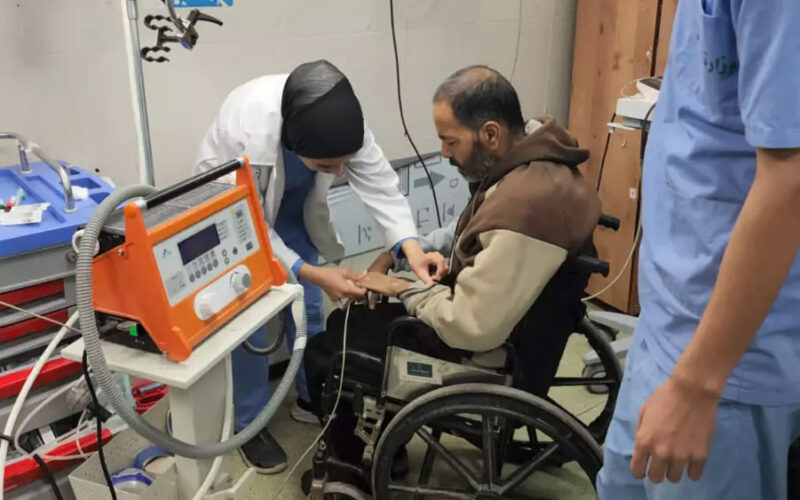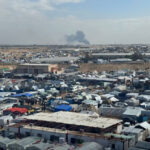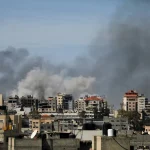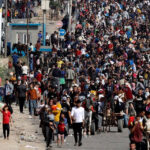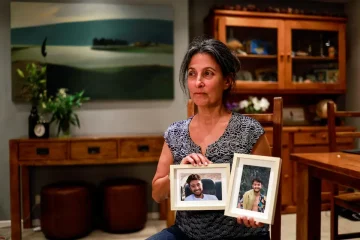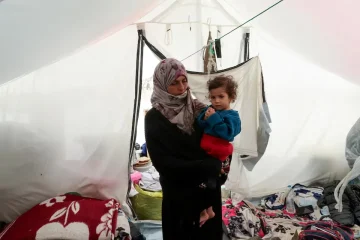NASSER Hospital in Khan Younis was until recently the largest medical facility still functioning in the Gaza Strip, despite facing severe challenges. But at the end of January, the Israeli military intensified ground operations in Gaza’s second-largest city, ordered civilians to evacuate, and began laying siege to the hospital.
Freelance journalist based in Gaza, writing under a pseudonym for safety given the security situation
The humanitarian situation inside is now catastrophic, with shortages of fuel, anaesthesia, and medical supplies, Gaza health ministry spokesperson Dr Ashraf al-Qudra told The New Humanitarian in a video interview. The Israeli military is preventing ambulances and wounded and sick people from reaching the medical complex, he added.
Israeli snipers are also reportedly shooting at people in the vicinity of the hospital. Twenty-one displaced people have allegedly been killed while trying to reach the facility, and at least seven others have been killed and more than a dozen wounded on the hospital’s grounds. On 8 February, a nurse was reportedly shot inside an operating theatre.
For weeks now, Nasser Hospital has only been “minimally functional”, according to the World Health Organization (WHO). Around 300 medical staff, 450 wounded patients, and 10,000 displaced people have been trapped in the compound, according to Gaza’s health ministry.
Nearly 29,000 people have been killed in Gaza – including more than 20,000 women and children – and more than 67,000 have been injured since the beginning of Israel’s military campaign on 7 October, according to health officials in the enclave, which is governed by Hamas.
The Israeli military began bombarding and laying total siege to Gaza following Hamas’ 7 October attack into Israel, which left around 1,140 people dead, around two thirds of them civilians, according to Israeli officials. Hamas and other Palestinian militant groups also took around 240 hostages back to Gaza. Around 134 are believed to remain in captivity.
The vast majority of Gaza’s population has been forcibly displaced and is being squeezed into the southernmost part of the enclave – which Israel is threatening to invade – while facing a catastrophic humanitarian situation, with aid organisations warning of famine and widespread disease outbreaks. On 26 January, the International Court of Justice, the UN’s top court, ruled that charges brought by South Africa accusing Israel of carrying out acts of genocide in Gaza were “plausible”.
Violence by the Israeli military and settlers has also escalated in the West Bank, where at least 384 Palestinians have been killed – including 97 children – since 7 October.
The New Humanitarian has provided regular updates from the hospital since Israeli forces invaded Gaza after the deadly raid into Israel on 7 October by Hamas, the Palestinian political and militant group that governs the enclave, reporting on the trauma, the burnout, and the loss suffered by staff as well as the deteriorating conditions at the facility.
Currently, there are over 20 patients in the hospital’s intensive care units, seven premature newborns, and dozens of patients in need of dialysis whose treatment has been interrupted because of the siege. according to al-Qudra, who added that more than 180 bodies had been buried in the compound since it was encircled because they couldn’t be transported elsewhere for burial.
“Food supplies have run out completely for the patients and wounded in the hospital, as well as the thousands of [displaced people] who took refuge in the hospital,” al-Qudra said.
After four months of war, none of the 36 hospitals in Gaza are fully functional any more. Medical facilities that remain partially functional are straining to treat large numbers of patients with limited supplies, according to the WHO. There have been more than 350 attacks on healthcare in Gaza since 7 October, the WHO said last week. Israel claims – without providing conclusive evidence – that Hamas uses hospitals for military purposes. Human rights groups have called for Israeli attacks on healthcare to be investigated as war crimes.
‘Other patients and I are bearing the cost’
Lying in one of the hallways of Nasser Hospital, Ali al-Akhras, 42, spoke to The New Humanitarian by video call. Al-Akhras was injured in late December in an Israeli attack while he was taking shelter in a school that has been turned into a refuge for the displaced.
Both of his legs have been amputated, and he is now unable to move and needs catheters and constant medical care. Since Israeli forces surrounded the hospital, he said he hasn’t been able to receive treatment.
“I survived the Israeli bombings, but there are no guarantees I will survive death in the hospital being deprived of medications.”
“Other patients and I are bearing the cost of the Israeli siege of the hospital. Doctors cannot access the hospital, and we cannot move or be transported to Rafah hospitals for proper medical care,” al-Akhras told The New Humanitarian. “Israeli snipers are everywhere, shooting people in the corridors of the hospital and the entrance.”
Prior to the Israeli forces surrounding Nasser Hospital, al-Akhras said he received medical tests and medications to alleviate his pain. His health has now deteriorated beyond the medical team’s capabilities to provide proper care, either because they couldn’t access the hospital or due to the lack of supplies.
“The world has to intervene before it is too late. Every day, we are slowly dying. I survived the Israeli bombings, but there are no guarantees I will survive death in the hospital being deprived of medications,” al-Akhras said.
‘No choice but to dig mass graves’
There has been no way to dispose of surgical or human waste since the siege of the hospital began, according to emergency room physician Hatem Rabaa.
“Besides the accumulation of waste in the hospital’s hallways, garbage and medical waste that should be handled attentively are also piling up in the hospital’s vicinity, posing an unprecedented health hazard,” Dr Rabaa said by phone.
“Hostilities against the hospital by the Israeli military are in line with the actions taken against al-Shifa Hospital, where the Israeli forces had besieged the hospital days before they stormed the facility.”
Manar Fayyad, an anaesthesiologist at Nasser Hospital
“Depleting medical supply means patients receive minimal medical care. This leaves paramedics having to prioritise which patients need urgent medical intervention,” he continued. “The encirclement of the hospital by the Israeli troops hampered families’ attempts to bury the bodies of deceased patients, leaving them no choice but to dig mass graves inside the medical facility itself.”
Attacks on medical facilities elsewhere in Gaza – including one in November on the largest in the enclave: al-Shifa Hospital in Gaza City – are increasing fear among the remaining medical staff at Nasser Hospital about what could happen next.
“Hostilities against the hospital by the Israeli military are in line with the actions taken against al-Shifa Hospital, where the Israeli forces had besieged the hospital days before they stormed the facility,” Manar Fayyad, an anaesthesiologist at Nasser Hospital, told The New Humanitarian.
‘Under heavy Israeli bombardment’
Other medical facilities in Khan Younis have also been targeted by the Israeli military campaign in the city. Al-Amal Hospital, run by the Palestinian Red Crescent, has been under siege for more than two weeks as well.
In an effort to try to continue to provide medical care, paramedics who worked at the Nasser Hospital have set up transit points in al-Mawasi – a region to the west of Khan Younis that is supposed to be an Israeli-designated so-called ‘safe zone’ – where people can be loaded into ambulances and transported to medical facilities that are still accessible. Medical staff from al-Amal, meanwhile, have set up an improvised clinic in al-Mawasi.
With Israel’s ground offensive on Khan Younis, which began in December, restricting medical personnel’s access to both the Nasser and Al-Amal hospitals – and both vicinities being regularly bombarded from the air – Nasser’s paramedics set up ambulance field points in al-Mawasi to carry patients to other hospitals in Rafah and Khan Younis. Al-Amal paramedics, on the other hand, decided to set up an ad hoc medical clinic in al-Mawasi town. Ibrahim Abu al-Kass, the Red Crescent staff member leading the initiative, said the clinic receives an average of 100 patients per day.
“The cases either directly arrive at the medical centre or are transported by ambulance away from areas under heavy Israeli bombardment,” he said.
After receiving initial care, patients are transported to hospitals in Rafah, to the south, or in Deir al-Balah, to the north, he added, but the journeys are often dangerous. At least 14 Palestinian Red Crescent ambulance crew members have been killed since the Israeli military campaign in Gaza began.

